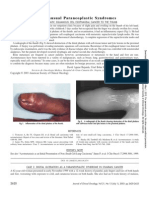Professional Documents
Culture Documents
Multiple Bilateral Choroidal Metastasis From Anal Melanoma
Multiple Bilateral Choroidal Metastasis From Anal Melanoma
Uploaded by
Moazzam FarooqiOriginal Title
Copyright
Available Formats
Share this document
Did you find this document useful?
Is this content inappropriate?
Report this DocumentCopyright:
Available Formats
Multiple Bilateral Choroidal Metastasis From Anal Melanoma
Multiple Bilateral Choroidal Metastasis From Anal Melanoma
Uploaded by
Moazzam FarooqiCopyright:
Available Formats
Int J Clin Oncol (2007) 12:303304 DOI 10.
1007/s10147-006-0651-9
The Japan Society of Clinical Oncology 2007
CASE REPORT James Haddow Danayya Muthapati Ilyas Arshad Mohit Gupta Pradeep Agarwal
Multiple bilateral choroidal metastasis from anal melanoma
Received: August 26, 2006 / Accepted: December 18, 2006
Abstract A 58-year-old Caucasian woman with bleeding per rectum had a melanoma of the anal canal. She subsequently presented with visual disturbance and was noted to have bilateral multiple choroidal metastasis, along with other multiple systemic metastases. Orbital radiotherapy led to near complete resolution of the ocular metastasis. Key words Choroidal Anal melanomas Metastasis
Introduction
We report a case of multiple bilateral choroidal metastasis from anal melanoma, with a brief review of the literature.
Case report
A 58-year-old Caucasian woman with a 2-month history of per rectal bleeding, pain on defecation, and a sensation of a lump in her anal canal was seen by the anorectal surgeon. She had also lost about 7 kg of weight in 2 months. Her past medical history was unremarkable, apart from dry eyes. On biopsy of an ulcerative lesion on the posterior wall of the anal canal, the diagnosis was conrmed as malignant melanoma of the anal canal. Systemic evaluation conrmed a single metastatic deposit in the right lung base. The melanoma was excised through the abdominoperineal approach. Two months after the operation she experienced nonspecic visual disturbances and ashing lights in both eyes. On examination in the eye clinic, her visual acuities were 6/62
in both eyes. Anterior segment and intraocular pressure was normal. Fundus examination after dilating the pupils with tropicamide 1% eye drops showed multiple raised amelanotic choroidal lesions with focal overlying serous elevations of the retina at the posterior pole in both eyes. A diagnosis of multiple bilateral choroidal metastasis was made. A positron emission tomography (PET) scan demonstrated these metastases, as well as additional widespread metastatic foci in the neck, thorax, abdomen, and pelvis. As the patient had multiple systemic metastases, after discussion with her she was started on adjuvant dacarbazine (DTIC) chemotherapy for palliation and radiotherapy to the orbits. On review 4 weeks later, the serous elevations and the choroidal lesions had decreased, with one possible lesion in the macular area in both eyes. Her visual acuity has stayed stable for 3 months since and she is still under follow-up.
Discussion
Primary anorectal melanoma is rare, accounting for 0.5% of all colorectal and anal malignancies1 and only 0.4%1.6% of all melanomas.2 It is more common in Caucasians; Cooper et al.3 reported that 81 out of 85 patients (95%) were Caucasians, 3 were African American, and 1 was mixed Asian and African American. The disease usually presents in the sixth decade of life and is more common in females. Rectal bleeding is the most common symptom at presentation, with others being a mass, tenesmus, suspicion of hemorrhoids, incontinence, inguinal mass, pruritus, change in bowel habit, and loss of weight.4 The diagnosis is often delayed, with a mean time from presentation to diagnosis of 45 months, and it is commonly misdiagnosed as hemorrhoids. Prognosis is poor, with an overall 5-year survival of around 10%.5,6 Metastatic disease is present in 15%38% of patients at the time of presentation,5,6 as it was in our patient, with pelvis, rectum, liver, vagina, lung, bone, skin, brain, colon, perineum, groin,6 and breast7 being the common sites.
J. Haddow I. Arshad P. Agarwal Department of Surgery, Pilgrim Hospital, Sibsey Road, Boston, UK D. Muthapati M. Gupta (*) Department of Ophthalmology, Pilgrim Hospital, Sibsey Road, Boston, UK, PE21 9QS Tel. +44-1205-446493; Fax +44-1205-356137 e-mail: mohiteye@yahoo.co.uk
304
The uveal tract is the most common ocular site for primary intraocular malignancy and also for metastasis from other systemic malignancies. Small metastatic foci to the uveal tract can be undiagnosed unless they affect the posterior pole and cause visual symptoms. All metastases to the uvea occur via hematogenous routes because there are no intraocular lymphatic channels. A choroidal metastasis is usually conned by Bruch`s membrane and appears as a creamy yellow-colored sessile or minimally elevated mass; it is often multifocal and bilateral. The tumor sometimes becomes signicantly elevated because it inltrates laterally. Occasionally the deposits assume a globular shape and mimic an amelanotic melanoma. Secondary exudative retinal detachment is frequent and may occur in eyes with relatively small deposits. The common primaries causing choroidal metastasis include breast and bronchial carcinoma, with metastasis also reported from the gastrointestinal tract, kidney, skin melanoma, prostate, ovarian carcinoma, pancreatic carcinoma, testicular embryonal carcinoma, carcinoma of thyroid, urothelial tumors, and primary adrenal lymphoma. The gastrointestinal tract tumors reported previously were adenocarcinoma of the esophagus, carcinoma of the colon, and carcinoma of the rectum.8 Uveal metastasis is best diagnosed by clinical recognition of the typical iris or fundus ndings. In cases where the choroidal lesion is atypical and metastasis is a diagnostic consideration, uorescein angiography, ultrasonography, or ne-needle aspiration biopsy can be used to make a denitive diagnosis.9 Management of uveal metastasis usually involves chemotherapy or irradiation. If the patient is receiving chemotherapy for systemic disease, then the choroidal metastasis can be followed without direct ocular treatment. If systemic chemotherapy does not control the uveal metastasis, then ocular irradiation (approximately 3500 cGy over a 4- to 5-
week period) is advisable. About half of the patients with choroidal metastasis require ocular irradiation, and the other half can be successfully controlled with chemotherapy or hormonal therapy.1012 To the best of our knowledge there is no previous report of choroidal metastasis from an anorectal melanoma. Also, ocular irradiation leading to near total resolution of the ocular metastasis is not very common.
References
1. Roumen RMH (1996) Anorectal melanoma in The Netherlands: a report of 63 patients. Eur J Surg Oncol 22:598601 2. Wanebo HJ, Woodruff JM, Farr GH, Quan SH (1981) Anorectal melanoma. Cancer 47:18911900 3. Cooper PH, Mills SE, Allen MS Jr (1982) Malignant melanoma of the anus: report of 12 patients and analysis of 255 additional cases. Dis Colon Rectum 25:693703 4. Pessaux P, Pocard M, Elias D, et al. (2004) Surgical management of primary anorectal melanoma. Br J Surg 91:11831187 5. Thibault C, Sagar P, Nivatvongs S, et al. (1997) Anorectal melanoma an incurable disease? Dis Colon Rectum 40:661668 6. Slingluff CL Jr, Vollmer RT, Seigler HF (1990) Anorectal melanoma: clinical characteristics and results of surgical management in 24 patients. Surgery 107:19 7. Ozgroglu M, Ozaras R, Tahan V, et al. (1999) Anorectal melanoma metastatic to the breast. J Clin Gastroenterol 29:197199 8. Linares P, Castanon C, Vivas S, et al. (2004) Bilateral choroidal metastasis as the initial manifestation of a rectal cancer. J Gastroenterol Hepatol 19:726727 9. Shields JA, Shields CL, Ehya H, et al. (1993) Fine needle aspiration biopsy of suspected intraocular tumors. Ophthalmology 100:16771684 10. Shields JA, Shields CL (1992) Metastatic tumours to the intraocular structures. In: Shields JA, Shields CL (eds) Intraocular tumours: a text and atlas saunders, Philadelphia, pp 207238 11. Shields CL, Shields JA, DePotter P, et al. (1997) Survey of 520 uveal metastases. Ophthalmology 104:12651276 12. Puri P, Datta SK (1998) Management of choroidal metastasis: a report. Eur J Cancer Care (Engl) 7:197200
You might also like
- 45 Siddaganga EtalDocument4 pages45 Siddaganga EtaleditorijmrhsNo ratings yet
- EmerencyDocument3 pagesEmerencySehrish SiddiqueNo ratings yet
- 48 Kalpana EtalDocument3 pages48 Kalpana EtaleditorijmrhsNo ratings yet
- Astec1 PDFDocument29 pagesAstec1 PDFSohailKhanNo ratings yet
- Porcel (2012) Clinical Implications of Pleural Effusions in Ovarian CancerDocument8 pagesPorcel (2012) Clinical Implications of Pleural Effusions in Ovarian CancerLyka MahrNo ratings yet
- Colon Adenocarcinoma With Metastasis To The GingivaDocument3 pagesColon Adenocarcinoma With Metastasis To The GingivaSafira T LNo ratings yet
- Neuroendocrine Tumors Dr. WarsinggihDocument20 pagesNeuroendocrine Tumors Dr. WarsinggihAndi Eka Putra PerdanaNo ratings yet
- Case Study in OrthoDocument15 pagesCase Study in OrthoDaryl Rojas Gabriel QuindiaganNo ratings yet
- Case ReportDocument5 pagesCase ReportFerdina NidyasariNo ratings yet
- OvarDocument52 pagesOvarAndrei BuruianăNo ratings yet
- Someunusualparaneoplasticsyndromes: Diagnosis in OncologyDocument6 pagesSomeunusualparaneoplasticsyndromes: Diagnosis in OncologyMohamed Nuri ShembeshNo ratings yet
- Referat Pleomorphic AdenomaDocument6 pagesReferat Pleomorphic AdenomaAsrie Sukawatie PutrieNo ratings yet
- Psu 50318Document4 pagesPsu 50318Dr Venkatachalapathy T S Ped SurgeonNo ratings yet
- Af13e6df 9c91 4284 A3ae Feb2bacbcba4Document7 pagesAf13e6df 9c91 4284 A3ae Feb2bacbcba4alberto cabelloNo ratings yet
- Otolaryngology Head and Neck Surgery 2011 Abadie P176Document2 pagesOtolaryngology Head and Neck Surgery 2011 Abadie P176Gus JanantaraNo ratings yet
- Rectal Cancer Partial VaginectomyDocument5 pagesRectal Cancer Partial VaginectomyArham ArsyadNo ratings yet
- Rare Peritoneal Tumour Presenting As Uterine Fibroid: Janu Mangala Kanthi, Sarala Sreedhar, Indu R. NairDocument3 pagesRare Peritoneal Tumour Presenting As Uterine Fibroid: Janu Mangala Kanthi, Sarala Sreedhar, Indu R. NairRezki WidiansyahNo ratings yet
- Ovarian TorsionDocument4 pagesOvarian TorsionRiko KuswaraNo ratings yet
- 03 JGLD PDFDocument2 pages03 JGLD PDFWiguna Fuuzzy WuuzzyNo ratings yet
- Ultrasoundforthe Diagnosisand Managementof Ureterolithiasisinthe Emergency DepartmentDocument3 pagesUltrasoundforthe Diagnosisand Managementof Ureterolithiasisinthe Emergency DepartmentMarcelitaTaliaDuwiriNo ratings yet
- 172 - 04 101 13 PDFDocument8 pages172 - 04 101 13 PDFAlexandrosNo ratings yet
- J Joms 2016 03 037Document12 pagesJ Joms 2016 03 037Gisela LalitaNo ratings yet
- Acute Appendicitis and Its CarcinomaDocument47 pagesAcute Appendicitis and Its CarcinomaOko EmekaNo ratings yet
- PDF DIR 378Document6 pagesPDF DIR 378Sidgi BadjriNo ratings yet
- Patterns of Pelvic Recurrence Following Definitive Resections of Rectal CancerDocument9 pagesPatterns of Pelvic Recurrence Following Definitive Resections of Rectal CancerboroumandNo ratings yet
- 48 Devadass EtalDocument4 pages48 Devadass EtaleditorijmrhsNo ratings yet
- Porcel Et Al - Pleura and Peritoneum - 2021Document7 pagesPorcel Et Al - Pleura and Peritoneum - 2021zdmoorNo ratings yet
- JournalDocument5 pagesJournalMuhammad SyariefNo ratings yet
- Texf Eu 2011 00600366 2Document8 pagesTexf Eu 2011 00600366 2JS57No ratings yet
- Fine Needle Aspiration Cytology in Diffuse or Multinodular Goitre Compared With Solitary Thyroid NodulesDocument1 pageFine Needle Aspiration Cytology in Diffuse or Multinodular Goitre Compared With Solitary Thyroid NodulesHo Yong WaiNo ratings yet
- Parathyroid Final PDFDocument4 pagesParathyroid Final PDFgeoschorNo ratings yet
- 157 161 RadiotherapyDocument5 pages157 161 RadiotherapyEko SetiawanNo ratings yet
- 2017-05 Norfolk and Waveney CPDG Policy Briefing Paper - Capsule EndoscoDocument4 pages2017-05 Norfolk and Waveney CPDG Policy Briefing Paper - Capsule EndoscoAlessioNavarraNo ratings yet
- Masas SuparrenalesDocument7 pagesMasas SuparrenalesAlexandra FreireNo ratings yet
- EBM 2018 - Head and CancersDocument136 pagesEBM 2018 - Head and CancersChandramohan SettyNo ratings yet
- Male Breast Cancer: An Institutional ExperienceDocument5 pagesMale Breast Cancer: An Institutional ExperienceIJAR JOURNALNo ratings yet
- Nipple Discharge 3Document3 pagesNipple Discharge 3Dima PathNo ratings yet
- Nephrogenic Adenoma Clinical Features, Management, and DiagnosticDocument19 pagesNephrogenic Adenoma Clinical Features, Management, and DiagnosticOswaldo MascareñasNo ratings yet
- Breast Carcinoma in Axillary Tail of Spence: A Rare Case ReportDocument4 pagesBreast Carcinoma in Axillary Tail of Spence: A Rare Case Reportrajesh domakuntiNo ratings yet
- Nephroblastoma: Radiological and Pathological Diagnosis of A Case With Liver MetastasesDocument5 pagesNephroblastoma: Radiological and Pathological Diagnosis of A Case With Liver MetastasesfifahcantikNo ratings yet
- Editorial: Metastatic Neoplasms To The Intraocular StructuresDocument3 pagesEditorial: Metastatic Neoplasms To The Intraocular StructuresDeniz MJNo ratings yet
- Aproximación Multidisciplinaria Al Diagnóstico y Tratamiento de La Obs Intestinal 2018Document124 pagesAproximación Multidisciplinaria Al Diagnóstico y Tratamiento de La Obs Intestinal 2018Jorge Nuñez LucicNo ratings yet
- AppendicitisDocument3 pagesAppendicitisRindayu Julianti NurmanNo ratings yet
- Rosendahl 2017Document7 pagesRosendahl 2017Prince VallejosNo ratings yet
- UreterostomiiDocument7 pagesUreterostomiivlad910No ratings yet
- 20 Iajps20102017 PDFDocument3 pages20 Iajps20102017 PDFBaru Chandrasekhar RaoNo ratings yet
- Cytoreductive Surgery and IntraperitonealDocument11 pagesCytoreductive Surgery and IntraperitonealJorge FallasNo ratings yet
- Search This SiteDocument20 pagesSearch This SiteDika Putra YudaNo ratings yet
- Ciliary Body Metastasis Masquerading As ScleritisDocument13 pagesCiliary Body Metastasis Masquerading As ScleritisDurgeshRastogiNo ratings yet
- Surgical Treatment of Primary Hyperparathyroidism: Clinical StudyDocument4 pagesSurgical Treatment of Primary Hyperparathyroidism: Clinical StudyDala VWNo ratings yet
- Metastatic Spread of Mucinous Cystadenocarcinoma of The Ovaries Into Abdominal WallDocument3 pagesMetastatic Spread of Mucinous Cystadenocarcinoma of The Ovaries Into Abdominal WallIsta Fatimah Kurnia RahmiNo ratings yet
- 54 Raviswami EtalDocument3 pages54 Raviswami EtaleditorijmrhsNo ratings yet
- Primary Sarcoma of The Ovary Clinicopathological CDocument7 pagesPrimary Sarcoma of The Ovary Clinicopathological CfeisalmoulanaNo ratings yet
- English Task Gynecology System: Case ReportDocument4 pagesEnglish Task Gynecology System: Case ReportCecepNo ratings yet
- 114-Article Text-170-1-10-20180209Document6 pages114-Article Text-170-1-10-20180209Munazzah MehakNo ratings yet
- Mediastinal Mass in A 25-Year-Old Man: Chest Imaging and Pathology For CliniciansDocument5 pagesMediastinal Mass in A 25-Year-Old Man: Chest Imaging and Pathology For CliniciansWahyu RianiNo ratings yet
- 009 - The-Perioperative-and-Operative-Management-of - 2023 - Surgical-Oncology-ClinicsDocument17 pages009 - The-Perioperative-and-Operative-Management-of - 2023 - Surgical-Oncology-ClinicsDr-Mohammad Ali-Fayiz Al TamimiNo ratings yet
- Giant Uterine Leiomyoma - Case Report and Review of LiteratureDocument3 pagesGiant Uterine Leiomyoma - Case Report and Review of LiteratureMan ManuelNo ratings yet
- Imaging of the Liver and Intra-hepatic Biliary Tract: Volume 2: Tumoral PathologiesFrom EverandImaging of the Liver and Intra-hepatic Biliary Tract: Volume 2: Tumoral PathologiesNo ratings yet
- Upper Tract Urothelial CarcinomaFrom EverandUpper Tract Urothelial CarcinomaShahrokh F. ShariatNo ratings yet



























































